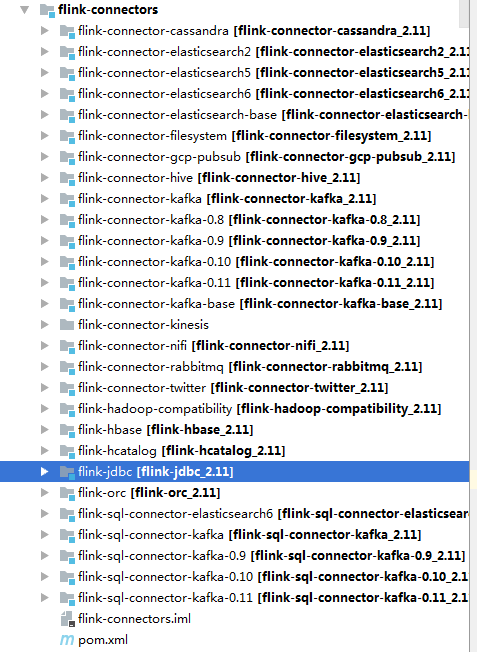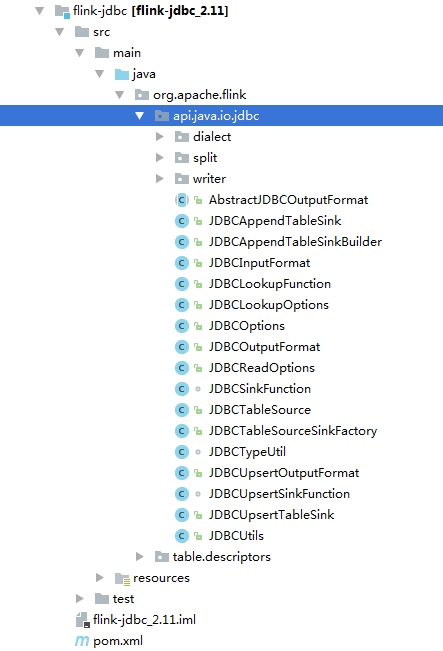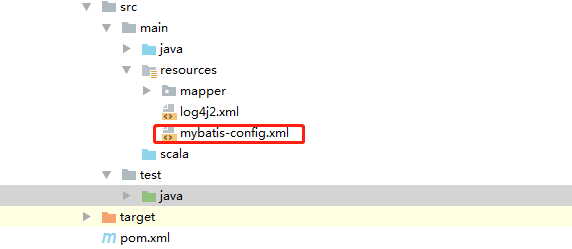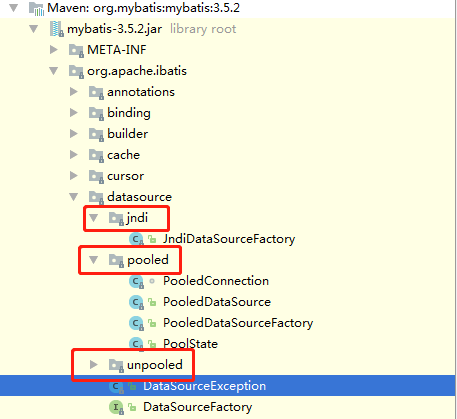flink 流式处理中如何集成mybatis框架
flink 中自身虽然实现了大量的connectors,如下图所示,也实现了jdbc的connector,可以通过jdbc 去操作数据库,但是flink-jdbc包中对数据库的操作是以ROW来操作并且对数据库事务的控制比较死板,有时候操作关系型数据库我们会非常怀念在java web应用开发中的非常优秀的mybatis框架,那么其实flink中是可以自己集成mybatis进来的。 我们这里以flink 1.9版本为例来进行集成。
-> 关注清哥聊技术公众号,了解更多技术文章

如下图为flink内部自带的flink-jdbc:

创建一个flink的流式处理项目,引入flink的maven依赖和mybatis依赖(注意这里引入的是非spring版本,也就是mybatis的单机版):
<properties>
<flink.version>1.9.0</flink.version>
</properties>
<!-- https://mvnrepository.com/artifact/org.mybatis/mybatis -->
<dependency>
<groupId>org.mybatis</groupId>
<artifactId>mybatis</artifactId>
<version>3.5.2</version>
</dependency>
<!-- flink java 包 -->
<dependency>
<groupId>org.apache.flink</groupId>
<artifactId>flink-streaming-java_2.11</artifactId>
<version>${flink.version}</version>
</dependency>
maven依赖引入以后,那么需要在resources下面定义mybatis-config.xml 配置:

mybatis-config.xml 需要定义如下配置:
<?xml version="1.0" encoding="UTF-8"?>
<!DOCTYPE configuration PUBLIC "-//mybatis.org//DTD Config 3.0//EN"
"http://mybatis.org/dtd/mybatis-3-config.dtd">
<configuration>
<typeAliases>
<typeAlias alias="BankBillPublic" type="xxxx.xx.xx.BankBillPublic" />
</typeAliases>
<environments default="development">
<environment id="development">
<transactionManager type="JDBC" />
<dataSource type="POOLED">
<property name="driver" value="com.mysql.jdbc.Driver" />
<property name="url" value="jdbc:mysql://xx.xx.xx.xx:3306/hue?characterEncoding=UTF-8&zeroDateTimeBehavior=convertToNull&allowMultiQueries=true&autoReconnect=true" />
<property name="username" value="xxxx" />
<property name="password" value="xxxx*123%" />
</dataSource>
</environment>
</environments>
<mappers>
<mapper resource="mapper/xxxxxMapper.xml" />
</mappers>
</configuration>
typeAlias 标签中为自定义的数据类型,然后在xxxxxMapper.xml 中parameterType或者resultType就可以直接用这种定义的数据类型。
dataSource type="POOLED" 我们使用的是mybatis中的POOLED 类型,也就是连接池的方式去使用。默认支持如下这三种类型。

我们也可以使用阿里巴巴开源的druid连接池,那么就需要引入对应的maven依赖,如下所示:
<dependency>
<groupId>com.alibaba</groupId>
<artifactId>druid</artifactId>
<version>1.0.14</version>
</dependency>
然后定义一个对应的druid的DataSource,如下所示:
import java.sql.SQLException;
import java.util.Properties;
import javax.sql.DataSource;
import org.apache.ibatis.datasource.DataSourceFactory;
import com.alibaba.druid.pool.DruidDataSource;
public class DruidDataSourceFactory implements DataSourceFactory {
private Properties props;
@Override
public DataSource getDataSource() {
DruidDataSource dds = new DruidDataSource();
dds.setDriverClassName(this.props.getProperty("driver"));
dds.setUrl(this.props.getProperty("url"));
dds.setUsername(this.props.getProperty("username"));
dds.setPassword(this.props.getProperty("password"));
// 其他配置可以根据MyBatis主配置文件进行配置
try {
dds.init();
} catch (SQLException e) {
e.printStackTrace();
}
return dds;
}
@Override
public void setProperties(Properties props) {
this.props = props;
}
}
之后就可以mybatis的配置中使用了,如下所示:
<?xml version="1.0" encoding="UTF-8"?>
<!DOCTYPE configuration PUBLIC "-//mybatis.org//DTD Config 3.0//EN"
"http://mybatis.org/dtd/mybatis-3-config.dtd">
<configuration>
<typeAliases>
<typeAlias alias="BankBillPublic" type="xxxx.xx.xx.BankBillPublic" />
<typeAlias alias="DRUID"
type="com.xx.mybatis.druid.utils.DruidDataSourceFactory" />
</typeAliases>
<environments default="development">
<environment id="development">
<transactionManager type="JDBC" />
<dataSource type="DRUID">
<property name="driver" value="com.mysql.jdbc.Driver" />
<property name="url" value="jdbc:mysql://xx.xx.xx.xx:3306/hue?characterEncoding=UTF-8&zeroDateTimeBehavior=convertToNull&allowMultiQueries=true&autoReconnect=true" />
<property name="username" value="xxxx" />
<property name="password" value="xxxx*123%" />
</dataSource>
</environment>
</environments>
<mappers>
<mapper resource="mapper/xxxxxMapper.xml" />
</mappers>
</configuration>
<mappers> 下面为定义的mybatis 的xxxxxMapper文件。里面放置的都是sql语句。
本文作者张永清,转载请注明出处:flink 流式处理中如何集成mybatis框架
xxxxxMapper.xml 中的sql示例:
<?xml version="1.0" encoding="UTF-8"?>
<!DOCTYPE mapper PUBLIC "-//mybatis.org//DTD Mapper 3.0//EN"
"http://mybatis.org/dtd/mybatis-3-mapper.dtd">
<mapper namespace="xx.xx.bigdata.flink.xx.xx.mapper.UserRelaInfoMapper">
<!--查询关键字匹配 -->
<select id="queryUserRelaInfo" parameterType="String" resultType="UserRelaInfo">
SELECT id AS id,
USER_NAME AS userName,
APPL_IDCARD AS applIdCard,
PEER_USER AS peerUser,
RELA_TYPE AS relaType,
CREATE_USER AS createUser,
CREATE_TIME AS createTime
FROM USER_RELA_INFO
<where>
<if test="applIdCard != null">
APPL_IDCARD=#{applIdCard}
</if>
<if test="peerUser != null">
AND PEER_USER=#{peerUser}
</if>
</where>
</select>
</mapper>
定义Mapper,一般可以定义一个interface ,和xxxxxMapper.xml中的namespace保持一致
注意传入的参数一般加上@Param 注解,传入的参数和xxxxxMapper.xml中需要的参数保持一致
public interface UserRelaInfoMapper {
List<UserRelaInfo> queryUserRelaInfo(@Param("applIdCard")String applIdCard,@Param("peerUser") String peerUser);
}
定义SessionFactory工厂(单例模式):
/**
*
* sqlsession factory 单例 事务设置为手动提交
*/
public class MybatisSessionFactory {
private static final Logger LOG = LoggerFactory.getLogger(MybatisSessionFactory.class);
private static SqlSessionFactory sqlSessionFactory;
private MybatisSessionFactory(){
super();
}
public synchronized static SqlSessionFactory getSqlSessionFactory(){
if(null==sqlSessionFactory){
InputStream inputStream=null;
try{
inputStream = MybatisSessionFactory.class.getClassLoader().getResourceAsStream("mybatis-config.xml");
sqlSessionFactory = new SqlSessionFactoryBuilder().build(inputStream);
}
catch (Exception e){
LOG.error("create MybatisSessionFactory read mybatis-config.xml cause Exception",e);
}
if(null!=sqlSessionFactory){
LOG.info("get Mybatis sqlsession sucessed....");
}
else {
LOG.info("get Mybatis sqlsession failed....");
}
}
return sqlSessionFactory;
}
}
使用mybatis 对数据库进行操作:
SqlSession sqlSession = MybatisSessionFactory.getSqlSessionFactory().openSession();
UserRelaInfoMapper userRelaInfoMapper = sqlSession.getMapper(UserRelaInfoMapper .class);
//调用对应的方法
userRelaInfoMapper.xxxx();
//提交事务
sqlSession.commit();
//回滚事务,一般可以捕获异常,在发生Exception的时候,事务进行回滚
sqlSession.rollback();
这里以mysql为示例,写一个flink下mysql的sink示例,可以自己来灵活控制事务的提交:
public class MysqlSinkFunction<IN> extends RichSinkFunction {
private static final Logger LOG = LoggerFactory.getLogger(MysqlSinkFunction.class);
@Override
public void invoke(Object value, Context context) throws Exception{
SqlSession sqlSession = MybatisSessionFactory.getSqlSessionFactory().openSession();
try{
//插入
LOG.info("MysqlSinkFunction start to do insert data...");
xxx.xxx();
//更新
LOG.info("MysqlSinkFunction start to do update data...");
xxx.xxx();
//删除
LOG.info("MysqlSinkFunction start to do delete data...");
xxx.xxx();
sqlSession.commit();
LOG.info("MysqlSinkFunction commit transaction success...");
}
catch (Throwable e){
sqlSession.rollback();
LOG.error("MysqlSinkFunction cause Exception,sqlSession transaction rollback...",e);
}
}
}
相信您如果以前在spring中用过mybatis的话,对上面的这些操作一定不会陌生。由此你也可以发现,在大数据中可以完美的集成mybatis,这样可以发挥mybatis框架对数据库操作的优势,使用起来也非常简单方便。
一旦集成了mybaitis后,在flink中就可以方便的对各种各样的关系型数据库进行操作了。
本文作者张永清,转载请注明出处:flink 流式处理中如何集成mybatis框架





